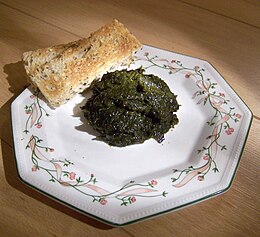Laverbread

Laverbread (.
Laver seaweed has been cultivated as a food in Wales since at least the 17th century. It is prepared by repeated washings and then boiling until it becomes the soft purée-like product known as laverbread. The gelatinous paste that results can then be sold as it is or rolled in oatmeal. It is sometimes also coated with oatmeal prior to frying. Laverbread is traditionally eaten fried with bacon and cockles as part of a Welsh breakfast or, in the southwest of England, with hog's pudding.
The alga

Laverbread is made from the seaweed Porphyra umbilicalis from the genus
Cultivation
Cultivation of laver seaweed as food is thought to be very ancient, though the first mention was in William Camden's Britannia in the early 17th century.[4] Laver seaweed cultivation is typically associated with Wales, and it is still gathered off the Pembrokeshire and Carmarthenshire coasts,[5] although similar farming methods are used at the west coast of Scotland.
Preparation
| Nutritional value per 100 g (3.5 oz) | |
|---|---|
| Energy | 146 kJ (35 kcal) |
5.11 g | |
| Sugars | 0.49 g |
| Dietary fiber | 0.3 g |
0.28 g | |
5.81 g | |
Niacin (B3) | 9% 1.47 mg |
| Pantothenic acid (B5) | 10% 0.521 mg |
| Vitamin B6 | 9% 0.159 mg |
| Folate (B9) | 37% 146 μg |
| Vitamin C | 43% 39 mg |
| Vitamin E | 7% 1 mg |
| Vitamin K | 3% 4 μg |
| Minerals | Quantity %DV† |
| Calcium | 5% 70 mg |
| Iron | 10% 1.8 mg |
| Manganese | 43% 0.988 mg |
| Phosphorus | 5% 58 mg |
| Potassium | 12% 356 mg |
| Sodium | 2% 48 mg |
| Zinc | 10% 1.05 mg |
| †Percentages estimated using US recommendations for adults,[6] except for potassium, which is estimated based on expert recommendation from the National Academies.[7] | |
It is plucked from the rocks and given a preliminary rinse in clear water. The collected laver seaweed is repeatedly washed to remove sand, then boiled until it becomes a stiff, green
Laverbread can be eaten cold as a
Laverbread is traditionally eaten fried with bacon and cockles as part of a Welsh breakfast. It can also be used to make a sauce to accompany lamb, crab, monkfish, etc., and to make laver soup (cawl lafwr).[10] Richard Burton has been quoted as describing laverbread as "Welshman's caviar".[11]
Laver seaweed is often associated with Penclawdd and its cockles, being used traditionally in the Welsh diet and is still eaten widely across Wales in the form of laverbread. In addition to Wales, laverbread is eaten across the Bristol Channel in North Devon, especially the Exmoor coast around Lynmouth, Combe Martin and Ilfracombe. In North Devon it is generally not cooked with oatmeal and is simply referred to as 'laver' (/ˈleɪvər/ LAY-ver).
Laverbread is highly nutritious because of its high proportions of
See also
- Palmaria palmata – Species of edible alga (Dilisk, Dilsk, Dulse)
- Gamet – Dried edible seaweed from the Philippines
- Green laver – Type of edible green seaweed in East Asian cuisine
- Kombu – Edible kelp
- Tsukudani – Simmered Japanese side dish
- Mastocarpus stellatus – Species of edible alga (Carrageenan moss)
References
- ^ a b "Laver Seaweed – A Foraging Guide to Its Food, Medicine and Other Uses". eatweeds.co.uk. 30 August 2018. Retrieved 22 March 2021.
- ^ "British food seaweeds". Everything2. Retrieved 6 May 2012.
- ^ "Laver nori". www.hospitalityinfocentre.co.uk. Archived from the original on 2013-11-03. Retrieved 2013-11-01.
- ^ Mason, Laura (2008-05-20). "Great British Bites: laverbread – Times Online". London: www.timesonline.co.uk. Retrieved 2008-08-10.
- ^ Don, Monty (2001-11-11). "Down your way". The Observer. London. Retrieved 2008-08-10.
- ^ United States Food and Drug Administration (2024). "Daily Value on the Nutrition and Supplement Facts Labels". Retrieved 2024-03-28.
- )
- ^ "Laverbread Parsons Pickles " Home". laverbread.com. Retrieved 2008-08-10.
- ^ "Laver Bread from Wild Food by Roger Phillips". app.ckbk.com. Retrieved 2021-05-04.
- ^ "Cawl lafwr (Laver soup)". Traditional Welsh Recipes. Archived from the original on 2010-02-07. Retrieved 2008-08-13.
- ^ "Black Mountains Breakfast". Brecon Beacons National Park. Archived from the original on 2008-10-12. Retrieved 2008-08-10.
- ^ a b Dunford, Jane (30 May 2010). "What's green, slimy and good for you?". The Daily Telegraph. Retrieved 7 January 2021.
- ^ "Welsh Laverbread - Protected food name with Protected Designation of Origin (PDO)" (PDF). Department for Environment, Food and Rural Affairs. 4 January 2021. Retrieved 7 January 2021.
- PMID 24803097.
Consumption of approximately 4 g of dried purple laver (Vitamin B12 content: 77.6 μg /100 g dry weight) supplies the RDA of 2.4 μg/day
Bibliography
- Lamb, Leeks and Laverbread, Gilli Davies, Grafton (16 Mar 1989), ISBN 0-586-20139-4
